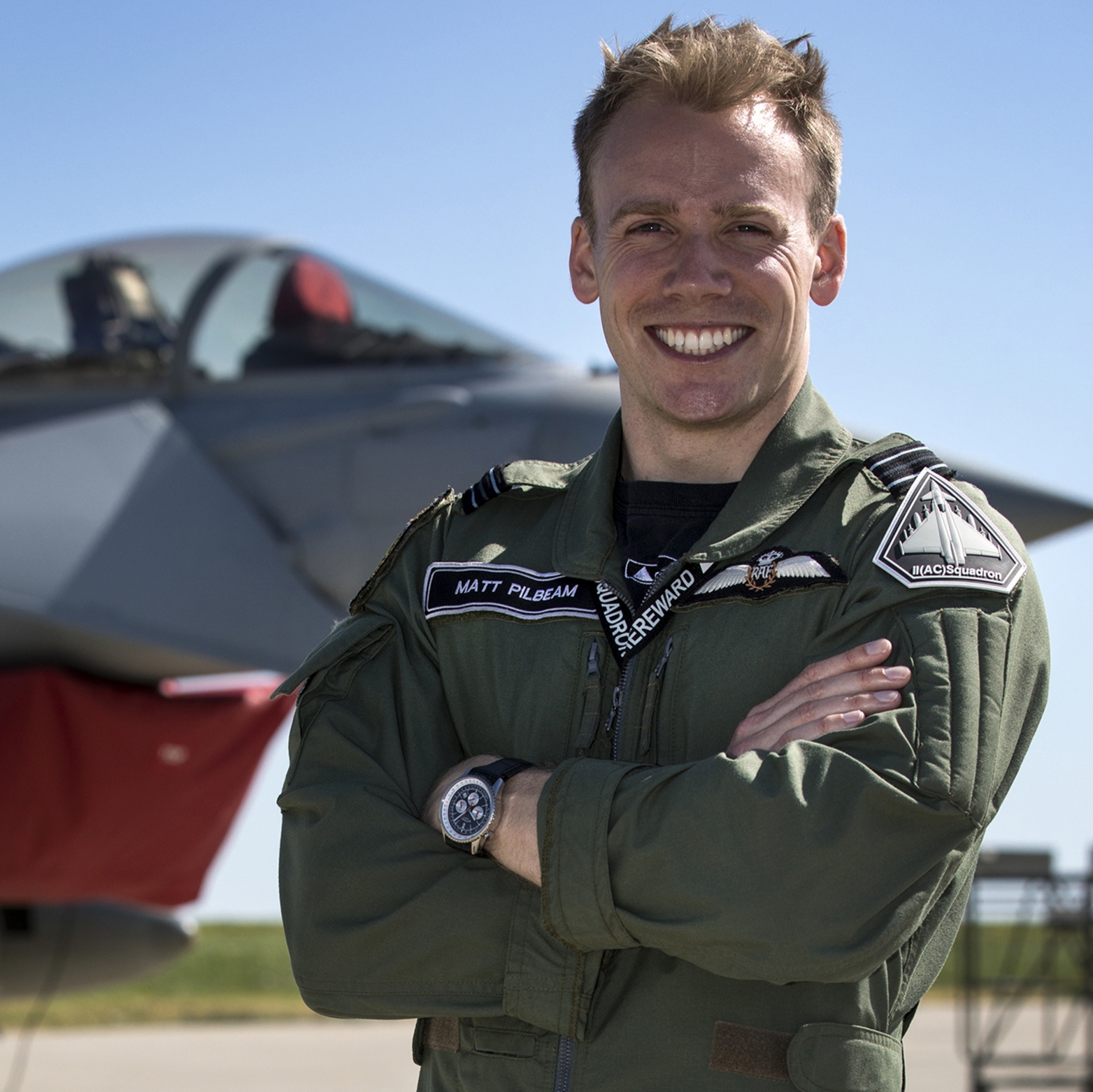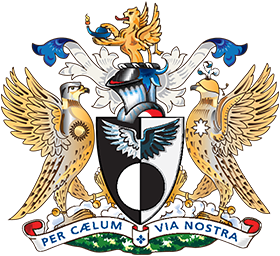- Home
- What we do
- News and Comment
- Scholarships
- International Air Pilots
- +44 (0) 20 7404 4032
- Member Login
The Master's Medal
Awarded to any person in aviation, at any time, for an act or other achievement in aviation considered worthy of the Medal, as soon as the facts of the event are clear. This is intended to be an immediate award, made at the discretion of the Master. It is done so on the advice of the Trophies and Awards Committee, after careful consideration and due diligence.
(Amended Terms of Reference 2019)
2023 awarded to: Flight Lieutenant Matthew Pilbeam RAF
Flight Lieutenant Matthew Pilbeam is a RAF Typhoon pilot serving with II(AC) Squadron. On 15 May 2022, he was flying one of two armed Typhoons on an operational mission over Iraq when both were forced to conduct an emergency diversion into Al Asad Air Base. After landing, the other pilot in his formation experienced a malfunction that prevented the cockpit canopy from opening. During a similar episode at this airfield in 2020 fire crews had cut through the canopy perspex to free the pilot as acute heat stress had become a risk to life. The pilot was also injured during the rescue. Given the extreme temperature of +41°C on this occasion, heat stress was a grave concern, so the engines were kept running to maintain cockpit cooling.
 While canopy troubleshooting was underway, the fuel became very low and aircraft systems began to overheat as fuel became insufficient for component cooling. This was a wicked problem: maintain engines running with a growing fire risk or shut them down and induce dangerous heat stress for the pilot without cockpit cooling. In addition, a stuck canopy left only two options: cut through the canopy or jettison it; both risked significant injury to the pilot. Further, the aircraft would have sustained structural damage that would have seen it unavailable for operations for several weeks.
While canopy troubleshooting was underway, the fuel became very low and aircraft systems began to overheat as fuel became insufficient for component cooling. This was a wicked problem: maintain engines running with a growing fire risk or shut them down and induce dangerous heat stress for the pilot without cockpit cooling. In addition, a stuck canopy left only two options: cut through the canopy or jettison it; both risked significant injury to the pilot. Further, the aircraft would have sustained structural damage that would have seen it unavailable for operations for several weeks.
Now on the flight line, Flt Lt Pilbeam quickly assimilated the situation and assessed that an engines-running refuel would buy precious time for the pilot. However, it was a brand-new procedure that was tightly-controlled and permissible only under the supervision of qualified Typhoon engineers – it had never been done in such a manner before. Faced with this dilemma, he acted decisively, judging the threat to life to be of far greater importance in this instance. He rapidly liaised with the local ground crew, who were unfamiliar with Typhoon, and closely supervised the aircraft refuel.
Once the refuel was completed, he switched his attention to freeing the trapped pilot. Eventually able to confer with Typhoon engineers in Cyprus via satellite communication, it was assessed that thermal expansion was the likely cause of the stuck canopy. Prompted by the fire truck in attendance, Flt Lt Pilbeam proposed a novel and innovative procedure to his engineers to douse the canopy in cold water and when validated, he swiftly led the attending fire crews through the procedure. This simple procedure had the desired effect and the canopy was freed without any damage to the aircraft.
Flt Lt Pilbeam’s ability to adapt, innovate and act quickly under pressure ultimately prevented serious injury to a fellow pilot and potentially saved his life. Through his composed and decisive actions, he also avoided significant damage to the aircraft that would have seen it stranded in a hostile environment and unavailable for follow-on missions at a busy time in the operational campaign. His actions were well beyond that to be expected in the situation and are thoroughly deserving of recognition by award of the Master’s Medal.
Previous Winners:
... of the Guild Medal
1976 F A Laker Esq
1977 awarded twice
Captain J Schuman (posthumously) and Herr J Veito of Lufthansa Flight 181
The Royal Air Force Red Arrow Aerobatic Team
... of the Master's Medal
1985 Captain John Testrake
1986 PO ACMN L Slater
1987 R Branson Esq and Per Lindstrand
1988 Captain S Yousif
1989 not awarded
1990 FO A Atchison
1991 Miss H Sharman
1992 not awarded
1993 Captain E J Wyer
1994 not awarded
1995 Air Cdre A N Nicholson OBE QHS RAF
1996 - 1998 not awarded
1999 Brian Jones and Bertrand Piccard of the Breitling Orbiter 3
2000 not awarded
2001 Polly Vacher
2002 Caroline Gough-Cooper and Imogen Asker
2003 David K Hempleman-Adams OBE
2004 HMS ENDURANCE
2005 Not Awarded
2006 The crew of 7 Flt AAC - WOI1 Challis (Aircraft Commander), Sgt Khanlarian and Cpl Leah
2007 Awarded twice:
Apache Patrol Members of 656 Sqn AAC
POACM James O'Donnell QGM
2008 not awarded
2009 Awarded twice:
The Crew of US Airways Flight 1549
Captain Charles "Chalkie" Stobbart
2010 Awarded twice:
Captain Michael Fairhurst and First Officer James Brown
Captain Stephen Noujaim
2011 Lt Cdr William Strickland USCG
2012 David "Wheely Dave" Sykes
2013 Awarded twice:
Lt Cdr Vincent Jansen USCG
Sgt Rachael Robinson QGM
2014 not awarded
2015 Solar Impulse - Dr Bertrand Piccard and Andre Borschberg
2016 Awarded twice:
Tracey Curtis-Taylor
Timothy Peake CMG BSc(Hons)
2017 Awarded twice:
Flt Sgt Mike Rowlands
Cdr Matthew Grindon RN
2018 not awarded
2019 Awarded to:
Winchman Paramedic Carlton Real
Wg Cdr Rob Caine MBE MA RAF
James Ketchall
2020 Flt Lt Richard Davoren RAF
2021 Awarded twice:
Lt Col Adam Thornton USAF
Flt Lt Matthew Douglas RAF
2022 Awarded twice:
Zara Rutherford
Mack Rutherford
2023 Flight Lieutenant Matthew Pilbeam RAF
- Company Objectives
- Professional Committees & Technical Groups
- Instructional Guides
-
Trophies & Awards
- The Trophies & Awards Committee
- Call for Nominations
- Terms of Reference for Awards
-
Award Winners
- The Award of Honour
- The Grand Master's Award
- The Master's Commendation
- The Master's Medal
- The Hugh Gordon-Burge Memorial Award
- The Prince Philip Helicopter Rescue Award
- The Barry Marsden Memorial Award
- The Sir Barnes Wallis Medal
- The Grand Master's Medal
- The Brackley Memorial Trophy
- The Johnston Memorial Trophy
- The Sword of Honour
- The Myles Bickerton Trophy
- The Hanna Trophy
- The Derry & Richards Memorial Medal
- The Eric 'Winkle' Brown Memorial Award
- The Sir James Martin Award
- The Cumberbatch Trophy
- The Glover Trophy
- The Central Flying School Trophy
- The Pike Trophy
- The John Landymore Trophy
- The Sir Alan Cobham Memorial Award
- The Grand Master's Australian Medal
- The Australian Bicentennial Award
- The Captain John Ashton Memorial Award
- The Jean Batten Memorial Trophy
- The Hugh Field Memorial Award for Aviation Journalism
- MAP MAN MRC
- Charities and Trusts
- Career Development
- Air Pilots Youth Gliding
- The City & the Livery
- Affiliated Units
The Honourable Company of Air Pilots
Air Pilots House, 52A Borough High Street, London SE1 1XN
Tel: +44 (0) 20 7404 4032
INCORPORATED BY ROYAL CHARTER
PATRON: HM THE KING
MASTER: RICHIE PIPER ESQ BSc(Hons) FRAeS
CLERK: PAUL J TACON BA FCIS
© 2024 The Honourable Company of Air Pilots

